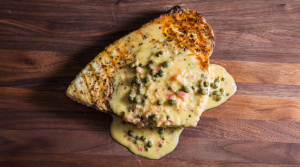
How To Make Grilled Swordfish Kabobs
Assembled with swordfish steaks and bay leaves on a stick, these well-seasoned grilled swordfish kabobs turn out deliciously charred and simply delicious.
Serves:
Ingredients
- 1½lbswordfish steaks
- 30bay leaves
- 4½tbspolive oil
- ¼cupdry bread crumbs
- 2tbspflat-leaf parsley,chopped
- ¾tspsalt
- ½tspfresh ground black pepper
Instructions
-
Light the grill or heat the broiler.
-
Thread the fish cubes alternately with the bay leaves onto 4 large skewers. Put the kabobs on a plate and brush all over with 3 tablespoons of the oil.
-
On a large plate, combine the bread crumbs, parsley, salt, and pepper. Holding the kabobs over the plate, pat the crumbs onto the exposed sides of the fish.
-
Drizzle with the oil left on the first plate and sprinkle with any crumbs that didn’t stick. Brush with the remaining 1½ tablespoons of oil.
-
Grill the kabobs over low to moderately low heat, or broil for 8 to 10 minutes, until the bread crumbs are golden and the fish is just done.
-
Serve with wine, and enjoy!
Recipe Notes
Wine Recommendation: A medium-bodied pinot noir from Oregon or California or a Bourgogne Rouge from France will be ideal with swordfish
Nutrition
- Calories: 421.54kcal
- Fat: 27.26g
- Saturated Fat: 5.01g
- Trans Fat: 0.08g
- Monounsaturated Fat: 16.29g
- Polyunsaturated Fat: 3.80g
- Carbohydrates: 8.58g
- Fiber: 1.64g
- Sugar: 0.44g
- Protein: 34.78g
- Cholesterol: 112.26mg
- Sodium: 462.30mg
- Calcium: 62.94mg
- Potassium: 763.59mg
- Iron: 3.15mg
- Vitamin A: 83.24µg
- Vitamin C: 4.62mg
Was this page helpful?
Have your own special recipe to share? Submit Your Recipe Today!






